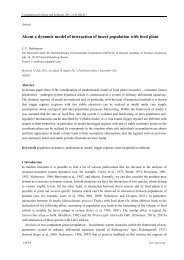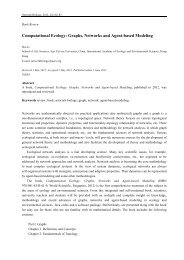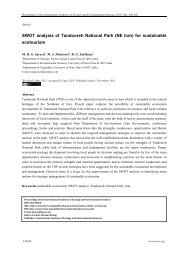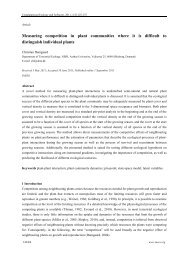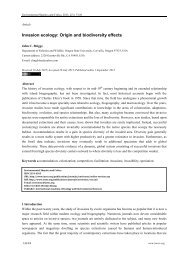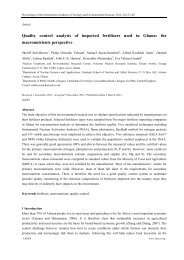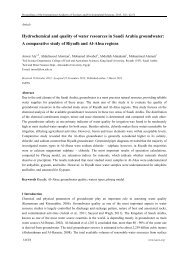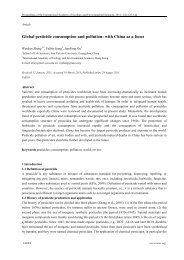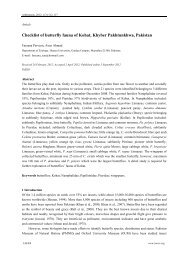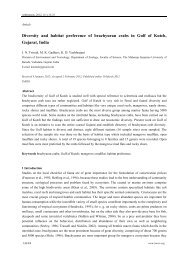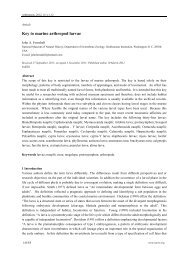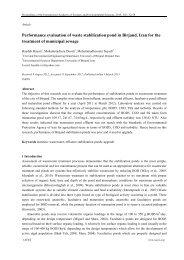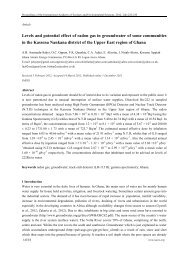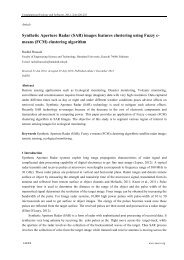Threatened medicinal plants of Menwarsar Pahalgam, Kashmir ...
Threatened medicinal plants of Menwarsar Pahalgam, Kashmir ...
Threatened medicinal plants of Menwarsar Pahalgam, Kashmir ...
You also want an ePaper? Increase the reach of your titles
YUMPU automatically turns print PDFs into web optimized ePapers that Google loves.
28<br />
Proceedings <strong>of</strong> the International Academy <strong>of</strong> Ecology and Environmental Sciences, 2013, 3(1): 25-35<br />
Table 2 Phytosociological Parameters <strong>of</strong> the threatened <strong>medicinal</strong> <strong>plants</strong> at menwarsar, <strong>Pahalgam</strong>.<br />
<strong>Menwarsar</strong><br />
Scientific name<br />
Density<br />
(<strong>plants</strong>/m 2 )<br />
Relative<br />
density(RD)<br />
Frequency (%)<br />
Relative<br />
frequency(RF)<br />
Important value<br />
Index (IVI) (%)<br />
P. hexandrum 1.73 0.41 66.66 0.38 0.90<br />
P. kurroa 1.2 0.28 40 0.23 0.59<br />
A. heterophyllum 0.56 0.13 23.33 0.13 0.31<br />
R. emodi 0.36 0.08 20 0.11 0.30<br />
A. benthamii 0.16 0.03 13.33 0.07 0.21<br />
M. aculeata 0.13 0.03 10 0.05 0.14<br />
Note: F, frequency; RF, relative frequency; IVI, Important valve Index.<br />
3 Results<br />
3.1 Density and distribution <strong>of</strong> species<br />
The distribution <strong>of</strong> species varied significantly among different habitats and none <strong>of</strong> the species occurred on all<br />
the habitats (Fig. 1 (a)-(f)). P. hexandrum was found on five different habitats, A. heterophyllum occurred on<br />
three while P. kurroa and R. emodi occurred on two habitats. The critically endangered M. aculeata recorded<br />
on only a single habitat type indicated its narrow distribution (Table 3). Flat table land and moist rocky slope<br />
were the preferred habitat types with each growing three species followed by moist meadows with two species<br />
while others grew only a single species each. The shady slopes regardless <strong>of</strong> their aspect also grow only a lone<br />
species i.e. P. hexandrum.<br />
Observation on the average distribution <strong>of</strong> the species across all sights revealed P. hexandrum to be most<br />
frequent (66.66%) followed by P. kurroa (40 %) and A. benthamii (13.33%) and M. aculeata (10%) as least<br />
frequent while A. heterophyllum (23.33%) and R. emodi (20%) were intermediate with moderate distribution<br />
(Table 2). While P. hexandrum (1.73 ind.m 2 ) and P. kurroa (1.2 ind.m 2 ) indicated highest density, the<br />
presence <strong>of</strong> P. kurroa in a single habitat type with the highest density emphasized its narrow and squeezed<br />
distribution. The least frequent M. aculeata had also the lowest density (0.13 ind. m 2 ).<br />
Important value Index (IVI) <strong>of</strong> each species was calculated to measure their numerical strength and assess<br />
their contribution to the total plant community. The highest IVI recorded is (0.90%) and lowest (0.14%) for P.<br />
hexandrum and M. aculeata, respectively.<br />
3.2 Folklore use <strong>of</strong> Assessed species<br />
The knowledge on the habitat distribution and <strong>medicinal</strong> use <strong>of</strong> these <strong>plants</strong> is maintained well within all the<br />
three ethnic tribes. The community elders and women folk have a handsome knowledge <strong>of</strong> the habitats, life<br />
history features, regeneration and uses <strong>of</strong> medicine <strong>plants</strong>. The continued belief <strong>of</strong> these communities on these<br />
high altitude easily accessible traditional <strong>medicinal</strong> <strong>plants</strong> and absence <strong>of</strong> alternative modern <strong>medicinal</strong><br />
facilities for them have greatly affected their source <strong>of</strong> medicine at this high altitude area. Data collected<br />
through the questionnaires highlighted the indigenous uses and reflected the collection, trade and reliance<br />
(Table 4) <strong>of</strong> these ethnic people on these <strong>medicinal</strong> <strong>plants</strong>.<br />
IAEES<br />
www.iaees.org



